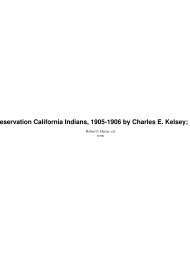Spring 2007 - Yosemite Online
Spring 2007 - Yosemite Online
Spring 2007 - Yosemite Online
- No tags were found...
Create successful ePaper yourself
Turn your PDF publications into a flip-book with our unique Google optimized e-Paper software.
YOSEMITE’S MUSEUMBY SUEANN BROWNA TRAILBLAZER IN PARK ARCHITECTURE AND NATURE EDUCATIONOne of the most significant buildings in <strong>Yosemite</strong>is located at the heart of <strong>Yosemite</strong> Village.Visitors pass through its doors every day, butfew realize the seminal role it played in the developmentof the National Park Service’s signature Rustic style. Infact, the <strong>Yosemite</strong> Museum was the first building constructedas a museum in the National Park system, andserved as the home of educational initiatives that wouldserve as models for park programs nationwide.Museum development at <strong>Yosemite</strong> began even beforethe creation of the National Park Service. As early as 1915,some exhibits prepared by Chief Ranger Forrest Townsley,primarily specimens of mounted wildlife, were displayedat the Chief Ranger’s office. In the fall of 1920, the oldJorgensen Studio building near Sentinel Bridge was madeavailable as museum space. That year, Ranger Ansel Hallwas designated as the Information Ranger. He began creatingmore displays. By the summer of 1921, exhibits in thetemporary museum quarters included a history room, ethnologyroom, natural history room, and terrarium. Theseexhibits were well received by visitors and inspired donationsof both cash and objects for the museum collection.In May of 1922, a collection of Indian baskets valuedat between ten and fifteen thousand dollars was donatedto the museum. The donation intensified Hall’s desirefor a new museum building—specifically a “fireproof”structure to protect the growing and valuable collections.At Hall’s request, architect Herbert Maier, then employedby the Buffalo Museum of Science as an exhibit designer,prepared plans and a color perspective sketch of theproposed museum.With plans and sketches of the proposed museum inhand, Hall began raising funds for the structure. The<strong>Yosemite</strong> Museum Association was formed to handlethe funds in 1923. As the National Park Service’s firstnonprofit cooperating association, the group was aprototype for associations that now exist for NationalParks nationwide. In later years, the group was renamedthe <strong>Yosemite</strong> Natural History Association and then the<strong>Yosemite</strong> Association.While initial fundraising went well, the amountcollected was inadequate for the type of building Halldreamed of. Realizing he needed additional support,Hall turned to Chauncey Hamlin, the president of theAmerican Association of Museums. The two men firstmet on a high Sierra hike in 1921. Hamlin broughta funding request to the Laura Spelman RockefellerMemorial fund. The fund approved a grant of $75,000 inJuly of 1924. Of that, $50,000 was to be used to constructthe building, with the remainder to be used for equipment,furnishings and salaries for the first three years.NATIVE ROCKS AND LOGSOnce the funding was secured, Hall met with HermonBumpus of the American Association of Museums (AAM)to begin planning the museum’s construction. As a firststep in the museum project, Bumpus directed Hall to builda branch museum and lookout station at Glacier Point.The AAM hired Herbert Maierin August to prepare the final plansand oversee construction of the newmuseum. Maier’s first assignmentwas to design the Glacier Point lookout.His plans were approved withindays, allowing construction to beginimmediately. The structure was completedin just over a month, makingit the first of the Park Service’s manytrailside museums.The Glacier Point lookout site,atop a cliff on the south side of the<strong>Yosemite</strong> Valley, was selected forits educational value. The shelterYOSEMITE RESEARCH LIBRARYHerbert Maier’s first proposed Museumdesign was far more ambitious than themodest building budget would allow.6 YOSEMITE ASSOCIATION, SPRING <strong>2007</strong>




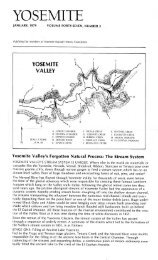
![(March 1982) [PDF] “We Are Pleased to Announce†- Yosemite Online](https://img.yumpu.com/51299748/1/190x242/march-1982-pdf-aeuroewe-are-pleased-to-announceaeur-yosemite-online.jpg?quality=85)
![[PDF] Old Horny, Yosemite's Unicorn Buck - Yosemite Online](https://img.yumpu.com/51269869/1/184x260/pdf-old-horny-yosemites-unicorn-buck-yosemite-online.jpg?quality=85)
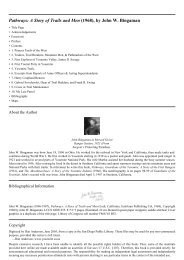
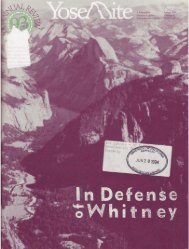
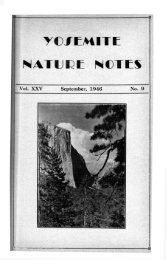
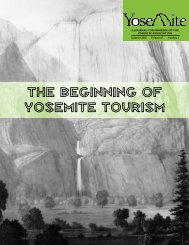
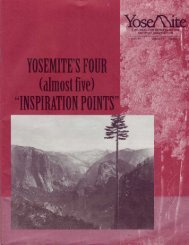
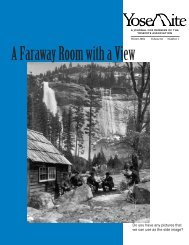
![1985 [PDF] - Yosemite](https://img.yumpu.com/48128837/1/184x260/1985-pdf-yosemite.jpg?quality=85)
